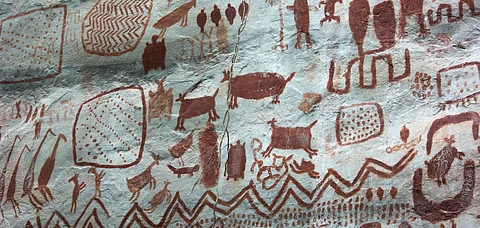
- Destinations
- Experiences
- Stay
- What's new
- Celebrating People
- Responsible Tourism
- CampaignsCampaigns
- SubscribeSubscribe
- Buy Now

Tucked inside the remote rainforests of Colombia (South America) are a series of cliffs bearing paintings which researchers believe throw light on how people lived in Amazonia during the Ice Age. The red coloured paintings, likely 11,800-12,600 years old, talk of the times when early people shared the earth with giant animals such as the mastodon.
According to media reports, the cliff paintings were discovered during excavations carried out between 2017 and 2018 by researchers from Exeter and Colombian universities with help from local communities. The European Research Council (ERC) funded project titled 'The End of the Journey The Late Pleistocene-Early Holocene Colonisation of South America' was led by archaeologist and archaeo-botanist Professor Jose Iriarte.
According to the researchers, South America was &lsquothe last habitable continent to be colonised by humans&rsquo. The research essentially focused on how early humans adapted to and influenced the environment around them, when they came across the paintings as well as food remains inside the caves. According to the article published in the Quaternary International, the research yielded &lsquothousands of remains of fauna, flora, lithic artefacts and mineral pigments, associated with extensive and spectacular rock pictographs that adorn the rock shelter walls&rsquo. The paintings have been dubbed &lsquoSistine Chapel of the Ancients&rsquo by the media.
Also Read Does India Hold a Dickinsonia Fossil
The paintings mostly consist of handprints, geometric patterns, human figures, plants and animals. Researchers mentioned in the published article that &lsquopreliminary observations of the rock paintings indicate that these early settlers may have drawn a variety of now extinct megafauna with impressive realism&rsquo. The Guardian quoted Professor Iriarte as saying &ldquoWe started seeing animals that are now extinct. The pictures are so natural and so well made that we have few doubts that you&rsquore looking at a horse, for example. The ice-age horse had a wild, heavy face. It&rsquos so detailed, we can even see the horse hair.&rdquo The largest sets of rock paintings have been found in an area named Cerro Azul outcrop.
The article published in the Quaternary International is available here.
Also Read On a Cave Art Trail Around India
The rock paintings were mostly executed using mineral pigments and ochre is the predominant colour. The researchers found many of the paintings depicted &lsquohunting and ritual scenes, showing humans interacting with plants, forest and savannah animals. Among the most abundant zoomorphic figures are deer, tapirs, alligators, bats, monkeys, turtles, serpents, and porcupines, among many others&rsquo. &ldquoImportantly, the rock art depicts what appears to be extinct Ice Age megafauna [giant sloth, mastodon, camelids, horses, and three-toe ungulates with trunks],&rdquo according to the researchers.
The paintings have also been featured in the second episode of the Jungle Mystery Lost Kingdoms of the Amazon aired by Channel Four where archaeologist and explorer Ella al-Shamahi delves into South America, in search of legendary cities and civilisations. The site was so remote that the team had to trek for four hours from a point reachable by a two hours&rsquo drive from San José del Guaviare (a town and municipality in Colombia).
